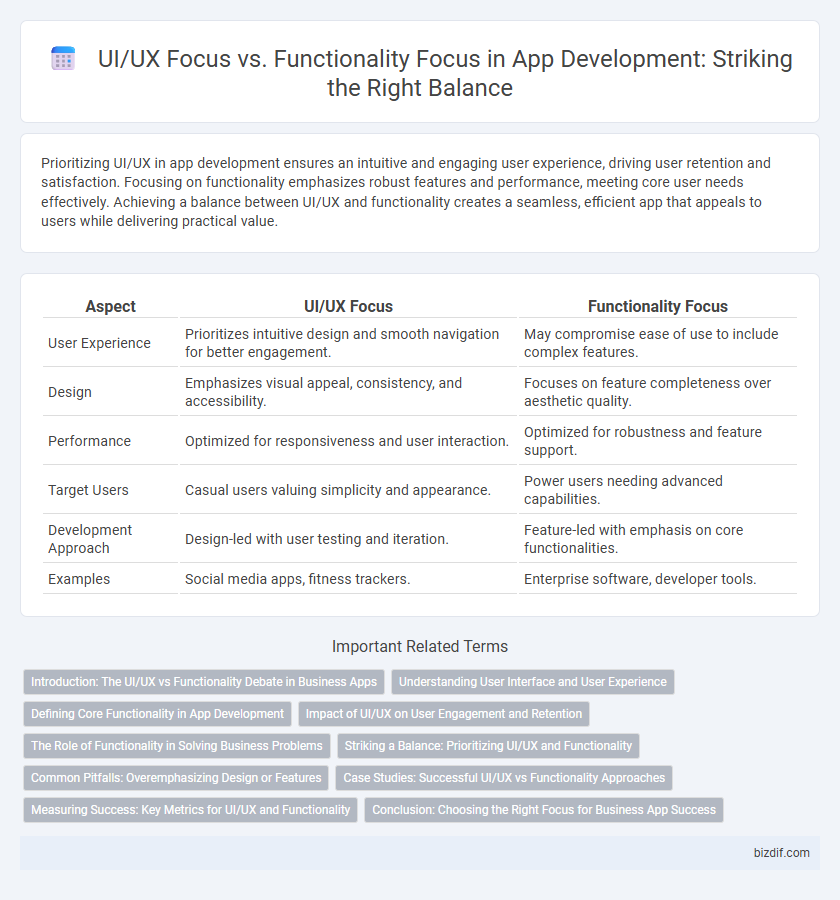Prioritizing UI/UX in app development ensures an intuitive and engaging user experience, driving user retention and satisfaction. Focusing on functionality emphasizes robust features and performance, meeting core user needs effectively. Achieving a balance between UI/UX and functionality creates a seamless, efficient app that appeals to users while delivering practical value.
Table of Comparison
| Aspect | UI/UX Focus | Functionality Focus |
|---|---|---|
| User Experience | Prioritizes intuitive design and smooth navigation for better engagement. | May compromise ease of use to include complex features. |
| Design | Emphasizes visual appeal, consistency, and accessibility. | Focuses on feature completeness over aesthetic quality. |
| Performance | Optimized for responsiveness and user interaction. | Optimized for robustness and feature support. |
| Target Users | Casual users valuing simplicity and appearance. | Power users needing advanced capabilities. |
| Development Approach | Design-led with user testing and iteration. | Feature-led with emphasis on core functionalities. |
| Examples | Social media apps, fitness trackers. | Enterprise software, developer tools. |
Introduction: The UI/UX vs Functionality Debate in Business Apps
Balancing UI/UX design with functionality remains crucial in business app development, as user-centered interfaces enhance engagement while robust features ensure practical utility. Research shows that 70% of users abandon apps due to poor usability, emphasizing the importance of intuitive design alongside comprehensive functionality. Prioritizing seamless navigation and responsive interactions drives user retention, ultimately maximizing business app effectiveness.
Understanding User Interface and User Experience
Prioritizing User Interface (UI) and User Experience (UX) in app development ensures intuitive navigation and enhances user satisfaction, leading to higher retention rates. A seamless UI coupled with thoughtful UX design streamlines interactions, reducing user friction and increasing engagement. Balancing aesthetic appeal with usability through user-centered design principles drives functionality that truly meets user needs.
Defining Core Functionality in App Development
Defining core functionality in app development ensures the product addresses primary user needs effectively, creating a solid foundation for future enhancements. Prioritizing essential features allows developers to deliver a seamless user experience without overwhelming users with unnecessary complexity. Balancing UI/UX design with focused functionality drives user retention and satisfaction by aligning performance with intuitive interaction.
Impact of UI/UX on User Engagement and Retention
A well-designed UI/UX significantly enhances user engagement by creating intuitive and aesthetically pleasing interfaces that simplify navigation and reduce cognitive load. Prioritizing user experience fosters higher retention rates as users are more likely to return to apps that feel seamless and enjoyable. Balancing functionality with compelling UI/UX design drives sustained app success by addressing both practical needs and emotional satisfaction.
The Role of Functionality in Solving Business Problems
Functionality in app development is critical for addressing specific business challenges by ensuring the app delivers practical solutions and seamless performance. A well-functioning app enhances operational efficiency, supports business processes, and meets user needs effectively, which directly impacts customer satisfaction and retention. Prioritizing functionality enables businesses to solve complex problems through automation, data management, and functionality-driven workflows, ultimately driving measurable business outcomes.
Striking a Balance: Prioritizing UI/UX and Functionality
Striking a balance between UI/UX and functionality is essential for successful app development, ensuring intuitive user interfaces complement robust performance. Prioritizing seamless navigation and aesthetic appeal enhances user engagement, while maintaining core functionality supports reliability and efficiency. Integrating user feedback and iterative testing drives optimal harmony between design and function.
Common Pitfalls: Overemphasizing Design or Features
Overemphasizing UI/UX design can lead to visually appealing apps with poor functionality, frustrating users seeking seamless interactions. Conversely, prioritizing features without intuitive design often results in complex interfaces that hinder user engagement and retention. Balancing aesthetic appeal with practical usability is crucial to avoid these common pitfalls in app development.
Case Studies: Successful UI/UX vs Functionality Approaches
Case studies reveal that apps prioritizing UI/UX, like Airbnb, achieve higher user engagement and retention by delivering intuitive navigation and appealing design. Conversely, functionality-focused apps such as Slack excel by integrating robust features that enhance productivity despite simpler interfaces. Balancing seamless UI/UX with powerful functionality proves crucial for sustained app success in competitive markets.
Measuring Success: Key Metrics for UI/UX and Functionality
Measuring success in app development requires analyzing key metrics such as user engagement, task completion rates, and error frequency to evaluate UI/UX effectiveness. Functionality focus is assessed through performance indicators like system uptime, response time, and feature utilization rates. Balancing these metrics provides a comprehensive view of both user satisfaction and technical reliability, ensuring optimal app performance.
Conclusion: Choosing the Right Focus for Business App Success
Selecting the right focus between UI/UX and functionality is crucial for business app success, as user engagement and operational efficiency both drive profitability. Prioritizing intuitive design enhances user satisfaction and retention, while robust functionality ensures reliability and task completion. Businesses should align development priorities with target user needs and market demands to achieve balanced and impactful app performance.
UI/UX focus vs Functionality focus Infographic

 bizdif.com
bizdif.com